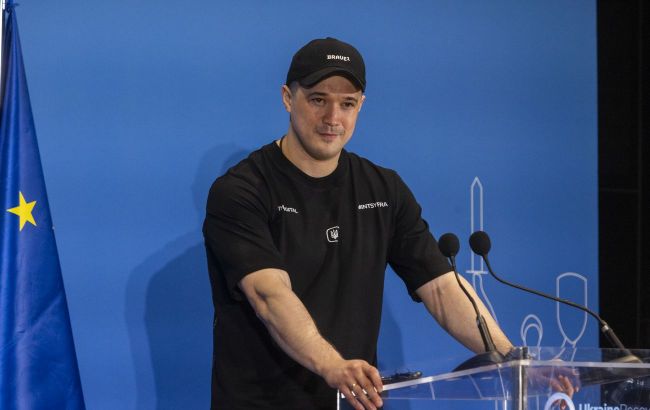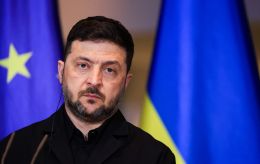Drones on the battlefield should be controlled from any city – Ukraine's digital minister Fedorov
 Deputy Prime Minister and Minister of Digital Transformation of Ukraine Mykhailo Fedorov (all photos: press service of the Ministry of Digital Transformation)
Deputy Prime Minister and Minister of Digital Transformation of Ukraine Mykhailo Fedorov (all photos: press service of the Ministry of Digital Transformation)
How Ukraine plans to respond to the Russian Shahed strikes, what military-tech projects have been agreed with the EU, what stage Ukrainian ballistic missile development is at, and what the future battlefield with AI could look like – read in an interview with Deputy Prime Minister and Minister of Digital Transformation Mykhailo Fedorov.
Last Friday in Rome, as part of the Recovery Conference (URC25), Ukraine and the European Commission announced the launch of a new initiative – BraveTech EU. The idea is that European military-tech startups, receiving funding from the EC, will be able to test their products directly on the battlefield in Ukraine, essentially similar to Ukrainian companies collaborating with the Brave1 project. These technologies are then expected to be deployed by the Ukrainian Defense Forces.
Europeans have solutions that could be of interest to Ukraine on the battlefield, especially since Russians still surpass Ukrainians in some components, says Deputy Prime Minister and Minister of Digital Transformation of Ukraine, Mykhailo Fedorov. A one-day or one-week pause will cost the country too much – there is a risk of falling behind in the tech race, Fedorov is convinced. As part of the new initiative, the minister said, there may be technology exchanges between European and Ukrainian companies, and even the creation of joint projects.
RBC-Ukraine in Rome spoke with Fedorov about how the new initiative with the EU will work, what Ukraine will gain from it, as well as about interceptors against Russian drones, a new motivation system for UAV units, a Ukrainian analogue of the Shahed drone, and the tech competition with Russia.
– In Rome today (the interview was recorded on Friday, July 11 – ed.), you and European Commissioner Andrius Kubilius announced the new initiative BraveTech EU. It's about tech exchange and battlefield testing, and startup funding. In short, how will it work, and why does Ukraine need it?
– Brave1 has already become Ukraine's largest angel investor in defense tech. In total, startups under the project have received over 2.2 billion hryvnias (approx 53 million US dollars) in grants. This year, even more will be issued.
How does it work? We set technical tasks for the market, search for solutions, and then scale them – we provide grants and test them at proving grounds and on the battlefield. Essentially, Brave1's successful experience is now being scaled to Europe. We're launching a European Brave, where we can continue to invest in both Ukrainian and European projects. There will be a separate budget for this.
We're creating a separate market for defense startups. For example, there are solutions involving CRPA antennas or autonomous drones, and European companies have them, but there was no platform to collaborate with them. Now we can run a hackathon, grant the winner, and then test everything on the battlefield in Ukraine.
– Could these be joint projects with Ukrainian companies?
– They could be individual European or Ukrainian projects, or joint ones.
– Will there be a tech exchange between Ukrainian companies and EU startups?
– We hope the tech exchange will happen organically. It's important to emphasize that we'll do everything we did for Ukraine, but now involving European startups. As a contribution to them, the European Commission is giving us money. They tell us: we have startups, but they aren't changing the course of the war in Ukraine. Can you help us by creating a platform where you issue the grants so there's a real outcome?
 Mykhailo Fedorov at a briefing with European Commissioner for Defense Andrius Kubilius
Mykhailo Fedorov at a briefing with European Commissioner for Defense Andrius Kubilius
– Initially, Ukraine and the EU will each contribute 50 million euros to the BraveTech EU fund. What kind of sums should the fund operate with in the future?
– It depends on how we start using the funds and the market size. We already see countries from both the EU and beyond ready to join the program. NATO separately wants to allocate funds.
– You saw that Europe has technologies we can use and proposed this startup-based format to the European Commission?
– Technologies have always been there. But there was no mechanism to build trust with these startups, to bring them to Ukraine, to give them feedback that something needs improvement. When you give them money, you can also give feedback and test more. So you become partners. We hypothesize that by creating a unified market of defense startups, we can find more cooperation with European companies. Maybe we'll see Ukrainian startups merge with European ones, as already happens in Ukraine.
– Will existing drone manufacturers be involved in the initiative? How?
– If they launch new projects and need resources, why not? But usually, projects come in where there's already an MVP (minimum viable product - ed.) and they want to scale it. Or the startup has an idea and wants to build a prototype. Companies with large contracts may have up to a 25% margin, as allowed by the government. So they can reinvest those funds.
– What exactly could Ukrainian tech-military startups produce together with European companies? What should be a priority? Drones, electronic warfare, explosives, something else?
– We'll have a strategic committee making those decisions. We hypothesize that these will be projects creating highly autonomous products, anti-guided aerial bombs, and anti-drone projects, such as those using fiber optics. Then we can scale all this depending on battlefield needs. What the battlefield will look like in six months – we don't know.
– FPV drones have long become the de facto main weapon of the war and have changed its course. Is this already the peak of evolution, or will something new emerge, like based on AI?
– We understand all the next evolutionary and revolutionary stages of military tech. FPV drones and autonomous copters will evolve. First, they'll better identify and strike targets even under electronic warfare. Then, they'll reach certain points without a connection. Eventually, drones will operate as a swarm in a shared network.
Drone autonomy will grow, but this requires funding for R&D. You can't just assemble a product from various components anymore - you need to invest in R&D and engineers. All this needs proper infrastructure, people, and scientific staff.
– Is Ukraine discussing with European partners how to break free from dependence on Chinese components?
– We believe that if we give Ukrainian companies a proper margin, they will begin to scale and localize component production. We already have one drone where 100% of the components are Ukrainian. I know many projects with 50-80% localization. The ability to have high margins and reinvest helps reduce dependency on Chinese supplies.
Plus, the share of American and European components is growing. The integration we're discussing could lead to European companies realizing they need to make more radars or certain cameras. We want European companies to "feel" the battlefield with their fingertips - then they'll better understand the market and what needs to be made. Maybe that will also influence component localization.

– Just the other day, there was an interesting story about how American troops at a training ground in Germany held innovative training - learning to drop a grenade from a drone (something that for Ukrainian soldiers already seems like a thing of the distant past). You constantly communicate with Western colleagues - would it be fair to say that Ukraine is already far ahead of many NATO countries in military tech, at least in certain sectors?
– We have different war doctrines. In the US, it's more of an air defense doctrine, where they aim to gain superiority in the sky, and for that, they need aircraft - manned and unmanned. They take out radars, then launch missiles. Our battlefield looks different. We have a 1,200 km front line, and no one can gain air superiority, so we're already fighting with other technologies, other types of drones. In this area, we are global leaders.
But if we're talking about planes and similar advanced tech, then of course, we're not leaders there. NATO is learning from us how to adapt its doctrines to modern warfare, and we are looking for strong solutions from our partners, adapting them to our realities and giving feedback.
In short, in some categories, we have complete superiority, and in others, we need a few or even dozens of years of R&D. The future definitely belongs to unmanned aircraft. Creating a plane, then an unmanned version of it, requires huge investments and years of research. The same goes for fully autonomous drones. Right now, our partners have begun learning rapidly - they're investing in Ukrainian companies, opening Ukrainian companies in their own countries. Something has shifted in the West over the past year - there's been a fundamental change, and now they're engaging with our companies and growing at incredible speed.
– Will we be opening up exports?
– The President has already announced that exports will be restricted. How exactly this will work – I can't say, because I'm not handling that matter.
– What about interceptor drones? Both you and the President have said we have a solution. Will we be able to shoot down the 700–1,000 drones that Russia seems to be planning to launch almost daily? Do we have a tech answer?
– Yes, interceptor drones are currently the most effective response. I can only say what the President has already said - the solution has been found, it's being scaled, and more than one company is working on it. We understand clearly what needs to be done next.
– What about Russia's jet-powered drones? Can our interceptors handle them?
– Of course, companies that have reached certain solutions are already working on countering jet drones, figuring out how to operate in cloudy weather, etc.
– It's a constant race. Russia launches Shahed UAVs, we respond with new electronic warfare systems. Then Russia learns to bypass those systems, putting 12–16 antennas on a drone. We find a solution there too, and then they launch jet drones. The process seems endless.
– That's exactly how it is. If we stop even for a day or a week, we risk falling behind Russia for good. That's why many companies are doing R&D, looking at what's coming in a week, in two weeks, in six months. Everything changes in real time.
– Are we keeping up with those changes?
– In some areas, yes, in others - not yet.
– For example, fiber optics. Many soldiers say Russia has an advantage there. Where's our weak spot - is it a lack of funds for scaling solutions, or is it a tech gap?
– Hard to say, because there are many dependencies. Sometimes we’re focused on other problems. Right now, for example, it's about countering Shahed drones. Russia doesn't have that problem; they have plenty of missiles and air defense systems. On a tactical level, we've always been strong, so the Russians are trying to hack our tactical advantage. They were the first to reach a solution for fiber-optic drones, and they've achieved more scale there.
We have a clear focus. You can't have success and breakthroughs in all technologies at once. This past year, we focused on interceptors for Shahed drones, and we got results. Now, maybe we'll shift focus to the tactical level and find game-changers there. We have a few more projects where we need to do our homework, in particular, fiber optics and guided aerial bombs. Until we find a way to counter those, certain frontline areas may take heavy hits.
– Should Ukraine create its own Shahed analog? And what's needed to scale deep-strike drone production to the level Russia has?
– We're not publicly saying how many drones we're launching now or how many we're producing. The issue isn't that our drones are much worse than Shahed UAVs. Russia has more air defense assets - they can shoot down our drones with aircraft and helicopters. Our air defenses don’t reach their helicopters, but theirs do reach ours. Also, they have a large supply of air defense missiles and can shoot down our Shahed analogs. In that regard, yes, we feel it. But in terms of the quantity and quality of drones and how they fly, well, for obvious reasons, we don't disclose that.
– What's going on with ballistic programs? Are you involved?
– We've issued several dozen grants through Brave1 for ballistic and cruise missiles. The companies that received the grants are now testing their products. We'll evaluate based on results.

– As of now, how is AI affecting combat operations, and how will its role grow over the next few months? Who's ahead – Ukraine or Russia? And to what extent can AI help physically protect our troops, since operators wouldn't need to be close to the front line?
– AI is already actively used to decode imagery, target enemies, interpret real-time transmissions, and even for AI-guided adjustments on FPV drones. We're launching a dedicated grant program in this area – this is the future of the battlefield. We need to get UAV operators off the battlefield.
Russia has created a Rubicon military unit that actively hunts our drone operators. So our mission is to enable remote operation as much as possible and eventually implement autonomy. That's the next stage of warfare. The goal is for an operator to control a battlefield drone from any city in the country. Beyond that, full drone autonomy. But that's probably a matter of years.
– Recently, you announced changes regarding target kill verification through Brave1 and the use of e-points. If I understand correctly, now units won't receive direct funds to buy drones, but rather the weapons and equipment themselves? Kind of like a marketplace?
– It's already essentially the Brave1 marketplace. We've expanded the categories - you can choose electronic warfare systems or other types of gear. A unit has a point balance, they make selections, the state pays the companies directly, and delivery and logistics follow. No need for contracting under the bonus system.
– Overall, how do you assess the e-point system?
– We see the numbers – some units have grown significantly and started receiving more drones, precisely thanks to this incentive system. There are also many indirect results. On one hand, a unit grows; on the other, we get data that helps us make sound management decisions.
Thanks to this, we understand the impact depth on the enemy: where we hit infantry, where we hit vehicles, how to extend strike distances, how many targets we find per day or week, and how many we hit, so the conversion rate. We know how many tools we lack, where we're shooting down enemy recon planes, how many, and on which sectors we're not succeeding - and why, like whether there's radar coverage. We've gathered real-time battlefield data that no other system has.
– Is there a problem with verifying destroyed targets?
– A certain culture has already formed. There are very responsible units - they upload high-quality data. We have several dozen verifiers who check this. Plus, we share one unit's data with others - there's always a way to verify.
– What are your plans for Brave1? Any initiatives you can announce?
– We'll be testing more products directly on the battlefield. The President signed a decree for 300 military personnel to work with Brave1. Thanks to this, we'll be able to find more battlefield game-changers. Plus, Brave1 is receiving more funding, and we'll be able to launch more grant programs. I expect that over the next six months, Brave1 will make major progress toward its mission - finding tech solutions that will change the battlefield situation.
This interview was made possible with the support of United24 and is also available on the United24 website.

